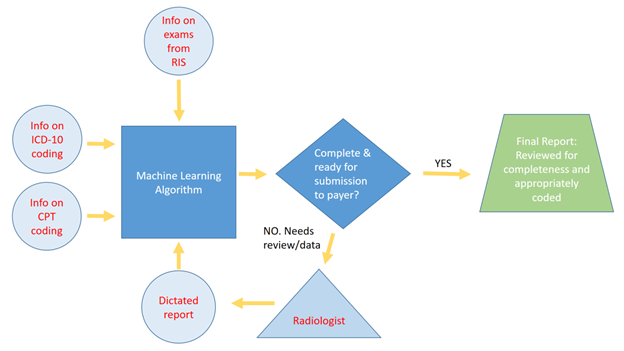|
Purpose |
Encourage development and implementation of patient follow-ups in radiology report recommendations. |
|
Tag(s) |
Non-Interpretative |
|
Panel |
Patient Facing subpanel |
|
Define-AI ID |
22110012 |
|
Originator |
Patient Facing Panel |
|
Panel Chair |
Andrea Borondy Kitts |
| Non-Interpretive Panel Chairs |
Alexander J. Towbin, Melissa Davis |
|
Panel Reviewers |
Non-Interpretive Panel |
|
License |
|
|
Status |
Clinical Implementation
Value Proposition
Studies using Electronic Health Records to assess if radiology reports and images are accessed by the referring clinician indicate that an estimated 7.5 to 15% of reports and images are not opened by the referring clinician. (1-3) Assuming that an unread radiology report is not contributing to patient care and may result in missed care opportunities, confirming that that radiology report reached the destination and was read by the ordering clinician will improve patient care.
An algorithm to confirm report receipt and viewing will improve patient care and reduce risk to the patient, radiologist, referring clinician, and institutions that employ them. It will lessen the need for alternative communication methods by radiologists resulting in improved efficiency. Additionally, notifying the patient of read receipts by referring clinicians will provide another layer of safety by encouraging patients to follow-up on their results if they are not contacted by the clinician or their staff about the test results.
References:
1. Alvin MD, Shahriari M, Honig E, Liu L, Yousem DM. Clinical Access and Utilization of Reports and Images in Neuroradiology. J Am Coll Radiol. 2018 Dec;15(12):1723-1731. doi: 10.1016/j.jacr.2018.03.004. Epub 2018 May 7. PMID: 29748082.
2. Galinato A, Alvin MD, Yousem DM. Lost to Follow-Up: Analysis of Never-Viewed Radiology Examinations. J Am Coll Radiol. 2019 Apr;16(4 Pt A):478-481. doi: 10.1016/j.jacr.2018.08.022. Epub 2018 Nov 3. PMID: 30396863.
3. Mehta TI, Assimacopoulos A, Heiberger CJ, et al. Opinions, Views, and Expectations Concerning the Radiology Report: A Rural Medicine Report. Cureus. 2019;11(10). doi:10.7759/cureus.5822
Narrative(s)
A 56-year-old female has a CT of the Abdomen/Pelvis performed for left lower quadrant pain. Radiologist reads the study and determines there is no diverticulitis. However, the following additional findings are reported: abdominal aortic aneurysm measuring 3.4 cm, indeterminate adrenal lesion, and left ovarian cyst measuring 3 cm. Radiologist determines that routine delivery of report is sufficient. Report is signed and sent for delivery.
Workflow Description
There are several possible options for report delivery. AI queries Radiology Information system (RIS) to determine method of delivery: Since RIS will know how the report was sent, the following methods could be used to determine method of delivery. Responses can be tracked to determine which delivery method was successful.
1. Sent to the provider through EMR integration. AI system queries the EMR system’s audit trail to determine when/if a report is read by a licensed practitioner and specifically by the ordering clinician.
2. Sent to the provider through non-affiliated EMR using HL7 or other integration. Same process as above is followed.
3. Sent to the provider by fax, e-mail, patient brings to next appointment or mail. A QR code would be included on these to confirm receipt by communicating back the read time and provider identity (NPI) to the AI system. The QR will trigger an identification process on the phone or website using NPI to verify ordering clinician receipt.
4. Sent to the provider directly through a report distribution portal connected to the AI with read receipt.
5. Sent through the DIRECT secure messaging system. DIRECT secure messaging (“DIRECT”) is a set of technical protocols and policies for the secure transmission of email messages containing patient health information.(4)
Reference:
4. Sujansky W, Wilson T. DIRECT secure messaging as a common transport layer for reporting structured and unstructured lab results to outpatient providers. J Biomed Inform. 2015 Apr;54:191-201. doi: 10.1016/j.jbi.2015.03.001. Epub 2015 Mar 10. PMID: 25766489.
Considerations for Dataset Development
|
Procedure(s) |
N/A |
Technical Specifications
Inputs
Radiology Report
|
Definition |
All imaging tests and procedures |
|
Data Type |
Text |
| Modality | All |
| Body Region | All |
| Anatomic Focus | All |
Primary Outputs
Read Return Receipts
| RadElement ID | N/A |
Secondary Outputs
Time to Referring Physician Report Review
|
RadElement ID |
N/A |
|
Definition |
Time in minutes |
|
Data Type |
Numerical |
|
Value Set |
Continuous |
|
Units |
Minutes |
Future Development Ideas
- Incorporate report receipt notification for patients all radiology reports including those with with urgent findings that were conveyed to referring physician by phone or other urgent notification process
- Acknowledgement of actionable findings
